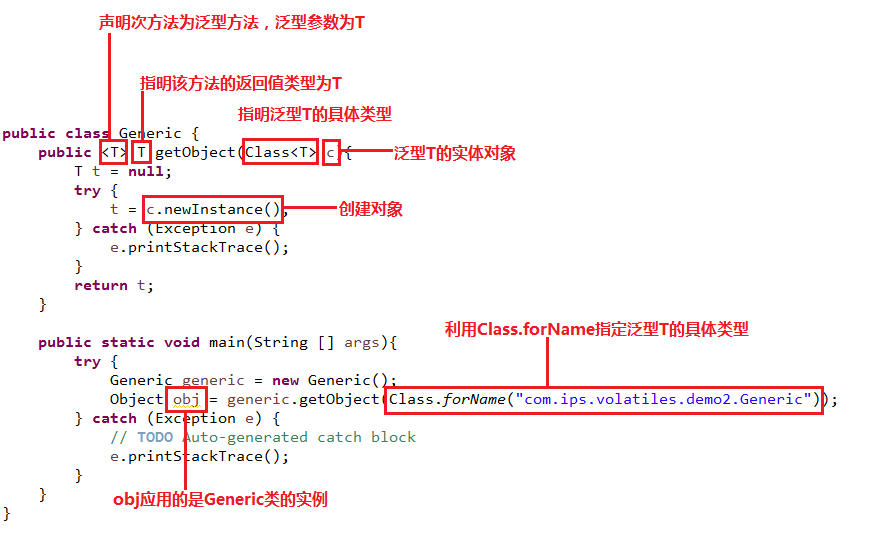泛型类
单参数泛型类:
public class Rectangle<T> {
private T width;
private T height;
public Rectangle(T width, T height){
this.width = width;
this.height = height;
}
public T getWidth() {
return width;
}
public void setWidth(T width) {
this.width = width;
}
public T getHeight() {
return height;
}
public void setHeight(T height) {
this.height = height;
}
public static void main(String [] args){
Integer width = 10;
Integer height = 5;
Rectangle<Integer> rect = new Rectangle<Integer>(width, height);
String widthStr = "20";
String heightStr = "40";
Rectangle<String> rect1 = new Rectangle<String>(widthStr, heightStr);
}
}通过public class Rectangle<T> {}定义泛型类,在实例化该类时,必须指明泛型T的具体类型,例如:Rectangle<String> rectangle = new Rectangle<String>();,指明泛型T的类型为String。
多参数泛型类:
public class Container<K, V> {
private K key;
private V value;
public Container(K k, V v) {
key = k;
value = v;
}
public K getKey() {
return key;
}
public void setKey(K key) {
this.key = key;
}
public V getValue() {
return value;
}
public void setValue(V value) {
this.value = value;
}
public static void main(String[] args) {
Container<String, String> c1 = new Container<String, String>("name", "Messi");
Container<String, Integer> c2 = new Container<String, Integer>("age", 30);
Container<String, Double> c3 = new Container<String, Double>("height", 1.78);
System.out.println(c1.getKey() + " : " + c1.getValue());
System.out.println(c2.getKey() + " : " + c2.getValue());
System.out.println(c3.getKey() + " : " + c3.getValue());
}
}通过public class Container<K, V> {}定义泛型类,在实例化该类时,必须指明泛型K、V的具体类型,例如:Container<String, String> c1 = new Container<String, String>("name", "Messi");,指明泛型K的类型为String,泛型V的类型为String。
泛型接口
public interface Calculator<T> {
public T and(T a, T b);
}
public class CalculatorInteger implements Calculator<Integer>{
public Integer and(Integer a, Integer b){
return a + b;
}
public static void main(String[] args) {
CalculatorInteger ci = new CalculatorInteger();
Integer val = ci.and(10, 20);
System.out.println(val);
}
}public class CalculatorString implements Calculator<String>{
public String and(String a, String b){
return a + b;
}
public static void main(String[] args) {
CalculatorString ci = new CalculatorString();
String val = ci.and("10", "20");
System.out.println(val);
}
}
通过public interface Calculator<T> {}定义泛型接口,在实现该接口时,必须指明泛型T的具体类型,例如:public class CalculatorInteger implements Calculator<Integer>{},指明泛型T的类型为Integer,实例化该类时无需制定泛型类型。
泛型方法
public class Generic {
public <T> T getObject(Class<T> c){
T t = null;
try {
t = c.newInstance();
} catch (Exception e) {
e.printStackTrace();
}
return t;
}
public static void main(String [] args){
try {
Generic generic = new Generic();
Object obj = generic.getObject(Class.forName("com.ips.volatiles.demo2.Generic"));
} catch (Exception e) {
// TODO Auto-generated catch block
e.printStackTrace();
}
}
}
泛型方法说明:
在调用泛型方法的时候,在不指定泛型的情况下,泛型变量的类型为该方法中的几种类型的同一个父类的最小级,直到Object。在指定泛型的时候,该方法中的几种类型必须是该泛型实例类型或者其子类。
在初始化泛型类的时候,不指定泛型的时候,泛型的类型为Object,就比如ArrayList中,如果不指定泛型,那么这个ArrayList中可以放任意类型的对象。
泛型的好处是在编译的时候进行类型安全检查,并且所有的强制转换都是自动和隐式的,以提高代码的重用率。























 334
334

 被折叠的 条评论
为什么被折叠?
被折叠的 条评论
为什么被折叠?








